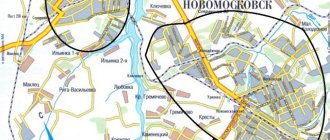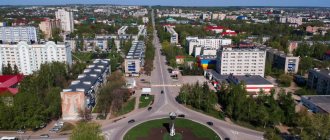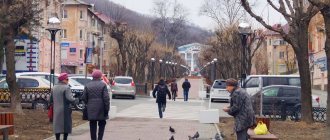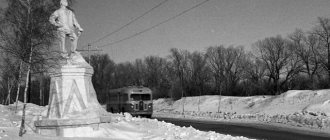Three Hierarchs “foreign” church, in which services were conducted partially in the Tatar and Mari languages. Photo by Sergei Sinenko
Sergey Sinenko
There is no Ufa-style disregard for antiquity here.
Birsk was founded in 1663 as a fortified city.
It is the second in time of foundation after Ufa, but, unlike Ufa, it managed to preserve its originality and historical face. It is impressive with its temples, storehouses, shopping arcades, and an abundance of high-quality stone buildings with intricate masonry. For its residents, the 350th anniversary of the city, which will be celebrated in September this year, is a huge event. The preparation for it is also large-scale. The entire historical center is being reconstructed. Oktyabrskaya (Troitskaya) Square has been improved. The restoration of the county treasury building and the fire tower with a stone arch was carried out. The memorial complex in Sokolok Park is being restored. The surgical and therapeutic buildings of the hospital are being renovated. The commissioning of the city cinema, sports and recreation complex and an extension to the city House of Culture will soon take place. Order has been restored in Lenin Park.
The Birsk Charitable Foundation, which united large city enterprises, allocated 30 million rubles for the reconstruction of the Holy Trinity Cathedral. By August, Biryans hope to see the temple in its original form and hear the ringing of bells. There are plans to improve the Belaya bank - a wide embankment with paths and lanterns is planned here. The roadway is being repaired not only in the city center, but also on the outskirts. A project of exceptional importance is the launch of the BioBirsk plant for deep processing of wheat; the first stage of the enterprise is planned to be launched in the third quarter. The whole of Birsk today is a large construction site.
It is surprising that the city has great tourism potential, but it has hardly been realized. But Birsk can become a place for architectural and historical excursions for Ufa residents, and then for guests of Ufa. If capital and overseas delegations are invited to Alekseevka to admire the wonders of agricultural technology, then I’m sure you need to feel the charm of ancient architecture and churches in Birsk. This will not only show the republic in its diversity and richness, but also help in the restoration of monuments and temples, and accelerate the development of urban infrastructure.
Birsk is no longer a musty province, but a lot needs to be done to change the image of the city. It is necessary to have a long-term program, such as a five- or ten-year program. It is important that it be realistic, take into account competing cities and the needs of the target audience, and have a proven step-by-step algorithm. Such a program needs to be worked out at the city and republic level, but, of course, using the positive experience of small historical towns in Russia.
There is no other city in the republic that is as historically valuable and has preserved its originality as Birsk.
I say with confidence: among the one-day walks that a Ufa resident can take by car, you will get the most vivid and varied impressions by visiting this ancient city. It’s a hundred and a half kilometers away, or an hour and a half journey; and if along the Zatonskaya highway, then the road is almost all good. Of course, you won’t see everything in one day, but you can understand something.
The Forgotten Soldier and the Forgotten Station
One of the attractions is a memorial sign that the Biryans call a “squiggle.” Among those who were involved in installing the monument on the “red line” is local businessman Oleg Bober. He explains: “Monument to Birsk oil workers. Steel fittings and bit mean a drilled well and shut-off valves installed on it. Our oil workers are known throughout Kogalym! Many of them started their own businesses in Birsk.”
Yes, the well-being of the townspeople, the construction of new microdistricts and cottage villages is directly related to the activities of the Birsk Drilling Directorate and the geological prospecting office. Many still work on a rotational basis. I criticize the “squiggle” a little from an aesthetic point of view. Oleg and his acquaintances in the Land Rover immediately suggest: “A monument to an Afghan warrior was recently erected. The whole city collected money. Let's go and have a look."
Monument to an Afghan warrior. Photo by Sergei Sinenko
The monument to the warrior is made in a realistic spirit. Undoubted luck. In monumental art with military themes, we are accustomed to the conventions and generalization of the image, and this convention has not touched us for a long time. The sculpture of a warrior resting on a stone impressed with its veracity. Everything is recognizable: the type of face of a young Russian man, a trophy unloading vest-bib for machine gun magazines with exactly three horns. The pose itself is sincere - hands on the Kalash, high boots resting on the stones. Afghan... That’s how it was, decisions were made at the very top, but the trace remained in the very outback, and no one clearly explained why we came to a foreign land with weapons in our hands?!
The monument was erected... right in front of the railway station. What, you ask, has a railway already been built through Birsk? Of course not.
The ancient railway station building is the only one in Russia that has never heard a locomotive whistle! Here is how it was. The merchant city really needed the railway. The local zemstvo has repeatedly proposed to build the Moscow-Kyshtym road through Birsk. Preliminary agreements were reached, and in 1907 the railway station began to be built in a hurry. And then disappointment - the project was rejected.
The Biryans did not calm down. In 1918, they planned to build a narrow-gauge railway from Ufa, but the Civil War interfered. But the issue has not yet been finally closed. The State Committee of the Republic of Belarus for Transport and Road Facilities has a promising project for the construction of a railway line from Ufa to Yanaul via Birsk. 182 kilometers of this road would shorten the journey from Ufa to Yekaterinburg by exactly half. There are no specifics on the timing, but Biryans, especially “modern merchants,” are very hopeful about this project, because along with the rails, the city will have new development prospects.
This building was built in Birsk as a railway station. Photo by Sergei Sinenko
Reflections at the monument to a merchant
In Birsk the people are not gloomy, it’s easy to talk. Especially if a non-resident is so sincerely surprised. And I’m surprised at this: among the bustle of people, I notice a sculpture - a bearded merchant in a caftan, and at his feet a dog guarding a casket. Right behind this monument, people sell little things from stalls. I have questions - what kind of merchant is this, why exactly a merchant? People are happy to enlighten a naive person. “Birsk is a merchant city from time immemorial.” “All the good houses here were built by merchants.”
Hmmm, I think, the merchant does not reap, does not sow, does not invent, does not produce anything. So, the transfer authority takes from some and sells to others. But for some reason he is needed in society. Not only socially, but even spiritually. He was, according to the Gospel, expelled from the temple into the world of everyday life. But that is precisely why in Rus' he appears as the custodian of ancient piety. As if a warning to us: returning to the temple, having once been expelled, is not so easy...
Afghan warrior, merchant... - good monuments appeared in Birsk. They are needed, they greatly enliven the city. The main thing is not to get carried away by the “ironic sculptures” that have recently multiplied throughout Russian cities, such as a monument to a plumber, a reveler or a dentist. It has become something of a fad.
Patriarchal Birsk does not need such plumbers. But erecting a monument to the founder of the city is a worthy task. Moreover, the decree of the Great Sovereign has been preserved, from which it is clear that the Ufa resident Ivan Ivanovich Chernikov-Anuchin, acting on the orders of the Ufa governor Pyotr Timofeevich Kondyrev, was sent to build the city of Birsk.
Of course, such a monument is not a quick task. I'm afraid the Biryans will tear me to pieces, but I'll still risk offering it. I see the monument to the first builder on Galkina Mountain, right in front of the Archangel Michael Church, above the hillside. Turning his face towards the river expanse, Chernikov-Anuchin points to the temple with his hand.
Birsk Holy Trinity Cathedral built in 1835-1840. it is planned to restore it to its original form. Photo by Sergei Sinenko
Birsk. Brief historical background
I. Location city
The city of Birsk is located in the northern part of the Republic of Bashkortostan, 103 km northwest of the capital of the Republic of Bashkortostan - Ufa on the elevated right bank of the Belaya River, at 55º 27` north latitude and 73º 11` east longitude. As of 01/01/18, the permanent population of the city of Birsk is 48,268 people. Occupied area – 6993 hectares.
II. Brief historical background
The history of the city of Birsk goes back centuries. Proof of this is the archaeological monuments discovered in the vicinity of the city - the Devil's Settlement and the Birsky burial ground, dating back to the 4th-8th centuries. n. e. The historical museum, where the history of the formation of our city is described in detail, links us with the city’s past. The foundation of the city of Birsk, the historiographer of the 18th century believes. Tatishchev, occurred before the founding of Ufa, as soon as Bashkiria joined the Russian state. It was then called after its founder, boyar Chelyadin, and after the church of St. Michael the Archangel - Chelyadin-Arkhangelsky. In 1662, the city was burned during the Bashkir uprising. The official founding date of Birsk is 1663, when Tsar Alexei Mikhailovich issued permission to build a new fortress on the right bank of the Belaya River and the left bank of the Bir River. To build the fortress, archers and gunners were sent from Kazan and the Moscow volost. After 13 years, the population in the fortress numbered 1,260 people. The fortress-town began to be called Birsk. In 1708, the city of Birsk was included in the Kazan province, in 1743. became part of the Ufa province of the new Orenburg province. During the Pugachev uprising, on June 18, 1774, Birsk was taken and burned by the troops of Salavat Yulaev. Since 1776, the city began to be rebuilt, and already in 1781, by decree of Catherine II, it became the center of the district in the Ufa governorship, then, in 1796, the district city of Orenburg, and in 1864. county town - Ufa province. Since the beginning of the 19th century. The city of Birsk becomes the center of grain and meat trade. Thanks to its favorable location on the Belaya River, the city became a transshipment base for goods sent from the north of the province to Ufa and beyond. The revival of transportation and trade contributed to the creation of the Birsk River Shipping Company in 1858. Gradually Birsk became a merchant city. According to the 1888 census, there were 8805 people in the city of Birsk, in 1915 there were 10 thousand people. By the beginning of the 20th century, in addition to retail outlets, there were several enterprises in Birsk: an oil mill, a brick factory, a soap factory, a slaughterhouse, a powder magazine, timber warehouses and sawmills, and a pottery settlement. Many merchants had mills. Until 1917, the city had five churches, a mosque, three chapels and a convent. The mosque (1912), the Holy Trinity Cathedral (1841), the Archangel Michael Church (1845) and the Foreign (now St. Nicholas) Church (1899), several merchant mansions from the second half of the 19th century to the beginning have survived to this day. XX centuries, representing undoubted historical and architectural value. On the initiative of the zemstvo court official, collegiate secretary A.R. Vatlashev, construction of the Holy Trinity Cathedral began in 1835 and continued until 1841. Twice - in 1885 and 1914. the building was rebuilt (expanded). In 1937 The main temple of the city of Birsk, the Holy Trinity Cathedral, was closed. The light drum, dome and bell tower were dismantled. The building was then used as a cinema. The Foreign Church (Three Saints: Guria, German, Barsanuphius), now St. Nicholas, was built between 1895 and 1899. for a foreign teacher's school. This is the only monument in Bashkortostan that is most consistently focused on reproducing the medieval Byzantine tradition. Michael the Archangel Church (built 1842-1845) was built at the expense of the Bir merchants Nikita Serebryakov and Danila Balaev, the current church. The former building of the city government and merchant assembly was built in the period 1909-1912, currently it houses the education department of the city and region. The building where school No. 1 is currently located was built by the merchant Taganov in 1910. Originally it was intended to house the Birsk railway station. Due to the fact that the railway did not reach the city, they decided to use the building as a trade and commercial school. The medical school building was built at the end of the 19th century as a former apartment building of the Surin homeowners. The building of the Birsk State Pedagogical Institute was built in 1903-1905 - the former building of the Birsk Real School. The building of school No. 3 formerly housed the city women's gymnasium, built in 1909. The building of the Birsk Distillery was built in 1901 on the site of the State Wine Warehouse, founded in 1894.
Share on social networks.
Oktyabrskaya becomes Troitskaya
The core of Birsk is the huge Oktyabrskaya Square. It is twice as large as Sovetskaya Square in Ufa. Fairs used to take place here, which attracted people from all over the Birsk district, and it was the largest in the Ufa province. Once on the square, I stop, already truly amazed. I see a huge dome over the building of the Aurora cinema. This means the cathedral is being restored!
Need clarification. The Birsk Holy Trinity Cathedral was built in 1835 - 1840 and rivaled in size even the Ufa Resurrection Cathedral, which accommodated up to three thousand people and was destroyed to the ground during Soviet times. In Birsk, they limited themselves to demolishing the huge church dome and building a cinema hall. For my book “Ufa Diocese” I searched in vain for a modern photograph in which the building would look attractive, but no, with the disturbed proportions the temple became an ordinary “movie”. And I didn’t even suspect that the dome of the cathedral had already been restored, so I simply gasped at the unexpectedly revealed beauty and majesty.
Work is in full swing. Installers are scurrying along the very edge of the sloping roof. What surprised and didn’t like was that they work without insurance, which must be a hindrance. You cannot rely on God’s help alone in such a matter.
I talked to a woman passing by. Nina is 66 years old and worked as a German language teacher at a pedagogical institute. “You would know how people are waiting for the opening of the Trinity Cathedral! This temple is a symbol of our city. Today everyone teaches, but some teach good, while others teach evil. When the temple is opened, the square will again become Trinity Square for us.”
I express to her the thoughts I recently heard in the Land Rover showroom: “Are there not many churches in one city, who will maintain them?” “I don’t know what kind of businessmen said that. The money for the restoration of the cathedral was given by the Birsk charity foundation - these are business people. Our entrepreneurs Alexander and Sergei Penzin, Alexander Afonin and others feed construction workers free of charge, give them bread and meat. And not only them, the whole city helps the construction. Yes, churches are visited by poor people, the majority are women. But for women it is especially important to be morally clean and physically tidy, because the family rests on them.”
I'm moving on. And here is the famous house of the merchant Chirkov. During the war years, it housed the military school of air surveillance, warning and communications, evacuated from Leningrad, where the outstanding composer Georgy Vasilyevich Sviridov studied. Now there is a library here. From the Church of the Three Saints I turn down Kommunisticheskaya Street. There are many springs in the city: Solyanka, Three Brothers, behind the 3rd school, in the ravine behind the old cemetery, in the Kalmazy lowland and on Malo-Kavkazskaya. And that is not all.
House of merchant Ivan Chirkov, view from the fire tower. Photo by Sergei Sinenko
origin of name
The famous Russian historian Tatishchev believed that the name of the city, which he received from the Bir River, comes from the Tatar word “bir”, which translates as “first”. The historian wrote that the Tatars gave this name because it was the first Russian fortress built in these places. Tatishchev also noted that the Russians themselves in 1555 called their settlement Chelyadin, after the name of the first builder of the city.
The generally accepted version is that Birsk got its name from the corresponding hydronym. The local population, Tatars and Bashkirs, call the river Bir-su (or Bire-suu), which translates as “wolf water”. In addition, old-timers, in accordance with urban legends, say that in former times the city was called Arkhangelsk, after the name of the first church in the name of the Archangel Michael, then built in it.
Specifics of a small city
I continue to communicate with the residents of Birsk, and not right away, but I understand that they are rather old-fashioned people. They read books, play the piano and know many other unnecessary things. For example, they remember who owned the monument houses: “The merchant Morozova lived in this one, Konovalov and Sizov lived in this one, and Ivan Petrovich Taganov built this one. Here is the house of the merchant Motygin, this is the store of the pharmacist Grebeshka, and this is the house of the midwife Vatlashova, here is the building of the City Government.” They don’t forget the old street names: “Internationalnaya used to be Millionnaya, Davletshina used to be Sokolina, Lenina used to be Sibirskaya.” In general, there is no Ufa-like disregard for antiquity.
Of course, it’s difficult for a city of forty thousand to compare with Ufa of millions. Other scales. But in one thing the residents of Birsk can compare with the residents of Ufa - their reverent attitude towards their own history, towards ancient architecture. And a natural question arises: why, where does such a difference come from? What is the reason? Let's try to figure it out.
First, of course, preparation for the anniversary. This year Birsk will celebrate its 350th anniversary. They decided to hold it on September 7, combining City Day and the Birsk Apple festival. Citizens and city leaders take this seriously. Preparations for the event have been underway for several years. The entire historical center is being restored. The condition of the monuments is also connected with this. But that's not all.
The specificity of a small town also emerges. Everyone knows each other, everyone is visible, the connections between people are much closer than, say, in Ufa. There are almost no strangers or newcomers in the city leadership - almost everyone grew up in Birsk or has lived here for quite a long time. For them, Birsk is not just a place to live, which is easy to change, which there is no need to take care of, but a city with which they are connected by blood. Such a person will think a hundred times before destroying a monumental house, but if he makes a mistake, the Biryans will remember this forever. In this sense, it is easier for the Ufa barbarians - they are anonymous.
It is also important that the antiquity itself remains in large quantities. Together with 104 historical and architectural monuments newly identified in small Birsk! There is something to save. The very atmosphere of the old city is nurturing. Of course, you can find interesting historical quarters in Sterlitamak, but not in such numbers.
Finally, I thought, it’s easier for a poor little town to save its face. Since there are no large financial flows, then there is no too obvious division between the poor and the super-rich, there are no defiantly arrogant mansions, cottage-style architectural chaos.
general information
The city is located in the southern part of the Urals, on the right mountainous bank of the Belaya River (a tributary of the Kama), near the confluence of the small Bir River. This is a forest-steppe zone on the Pribelsky ridge-undulating plain.
Received city status in 1781. Birsk is the administrative center (since August 20, 1930) of the district of the same name and urban settlement of the Republic of Bashkortostan. The capital of the republic, the city of Ufa, is 100 km away. The regional highway Ufa – Birsk – Yanaul runs nearby.
The city has historical and religious buildings that create a unique atmosphere of a provincial Russian town. Architectural monuments include the Holy Trinity Cathedral, St. Nicholas Church, Michael the Archangel and Intercession Church. The one-story buildings of the 19th century are well preserved.
View from the fire tower
There is a point from where you can look around the entire city at once - the fire tower. I was in Birsk about ten years ago and remembered the tree sticking out of this tower. Now I am happy to notice that there is no tree that represents devastation. And here is a brick arch in a semicircle. In good condition, but something is wrong. I remember: there used to be a lantern hanging under the arch, but now it’s gone. Biryans, tell me where the flashlight is, because for your unique arch this is an important, historical detail.
Fire arch built in 1914. Photo by Sergei Sinenko
During the day I was looking for a way to get to this very tower. The keys are kept in the city administration, in the cultural department. Finally it worked. It's difficult to get there. I make my way through the assembly hall, right behind the stage, and at that time poems about love are being read on it. A wooden staircase with wide steps, but they never end - the height of a tower is rare. Illegible scratching on the wall reads: “He entered service in 18... as a fireman...”. In general, historicity in everything.
The whole of Birsk opened up from above. There was no sun, but the surroundings looked nice. No smoke is visible. Peace. A quiet world, where there is no movement, no sound. To the south is Sokolok Park, a favorite vacation spot for townspeople. Everyone is familiar with the saying: “Sokolok, oh Sokolok, Belsky open spaces!” Why go to the Caucasus, there are such mountains here!”
Directly to the west in Zabelye is Lake Shamsutdin, a famous swimming and fishing spot. This is the Belaya oxbow, stretching for eleven kilometers.
Birsk is located very compactly, but you understand this only when looking from the fire station. Here are Galkina Mountain, Kalmaza, Dog Village, Kuliga, Short Lozhki, Old Crossing, Kurmysh. The names are very juicy. About the part of the city next to the river they say: Pokrovskaya Square, “lower bazaar” or simply “lower”. Birsk has its own Pavlov's House, Ganduras, Teacher's House, Barracks, Zibuny and the Pentagon. The house where famous hooligans lived is called Chicago.
From the tower you can clearly see the old building of the 3rd school on Kommunisticheskaya Street. I want to talk about it separately. There is a concept called “patina of time.” This is an oxide that gives special value and nobility. Under no circumstances can it be cleaned off; it is a trace of eternity, because truth, “realness” is verified only by long existence. If the building of the 3rd school is painted, it will lose all its historicity. The stonework here is elegant, especially the semicircular elements, and with time and rain the protrusions have been whitened, exposing the lower layer and creating a complex pattern on the red background, only emphasizing the skill of the masons. Biryans, please don’t do anything with the façade. Believe me, this is already a masterpiece. It's clearer from the outside.
The building of School No. 3 retains the “patina of time.” Photo by Sergei Sinenko
Main streets of Birsk
Mira street
Starts on the street. Revolutionary, ends at the roundabout leaving the city. The longest street in the city. Here are located: the Birsk Medical and Pharmaceutical College, the Birsk Physical and Wellness Center, the tax office, the traffic police, a monument to the uprising of E. Pugachev, a monument to the 50th anniversary of the discovery of oil.
Chevereva Street
Starts from the street. Davletshina, ends on the street. International.
Here are located: the Faculty of History, Birsky Multidisciplinary Professional College.
Gagarin street
Starts from the street. The world ends on the outskirts. The fire department is located here. It also passes by collective garden plots.
Koltsevaya Street
Starts on the street. Gagarin and ends at the exit from the city on highway 80K-029. It passes by the collective garden plots Rodnichok and Sosnovy Bor.
Tsyurupa Street
Starts from the street. Ak-idel ends at the exit from the city. The Cathedral Mosque is located on it.
Republican Street
Starts on the street. Annular. Since the street is double, it ends with a turn in the opposite direction.
Galkina mountain
The city administration uses historian Vasily Beloglazov as a “magic wand” - he knows what to show in the city and tells interesting stories. Together with him we go to the old coastal part of the city. Almost all of it consists of small estates and estates. Almost the same way of life.
I'm not embarrassed to look into the windows. Ficus trees, a large globe, a plastic jaw in a glass of water happily shines, as if it has taken root. Behind a low fence are long woodpiles, sheds and sheds, swings, benches, plank restrooms. In winter, Kustodiev's style shines through, in summer - Polenov's, in autumn and spring - Savrasov's, in general, the artist has freedom for sketches.
There are, of course, such dilapidated buildings that you think: this is the outskirts of civilization. Poverty, abandonment. But when there is no choice, a person will call both a barn and an animal hole a home. The world behind these fences seems grey. But it is gray-stable and therefore also durable in its own way: life is difficult, but possible.
The heyday of Birsk was due to the fact that it turned out to be the second most important river port after Ufa. The main cargo was bread, which flocked here from the entire northern part of the Ufa province. We talked with an employee of the Birsk port, Alexey. “You know, there are such screamers: “I love Birsk!” Sometimes it gets to the point where they show others: “Look, he doesn’t like Birsk! He is Birsk’s enemy!” And I love the city as much as I don’t. Despite all this, he never renounced. And the attitude towards the state is the same. There is no way out of it, at least for me there never was. And there was no need to go out. Whatever the leadership, the government is one thing, and Russia is another.”
On the site of the historical origin of the city today there is a church, a prison and a cemetery. It is in this sequence that I explore Galkina Mountain. As it should be, the Archangel Michael Church dominates the area. It stands on the highest point of the hill above the Belskaya steep. Now, after the restoration of the bell tower, it seems even more majestic.
Michael the Archangel Church on Galkina Mountain. Photo by Sergei Sinenko
I go to church. Meeting women Alevtina, Tatyana. Others are wary, refuse to identify themselves, but express the opinion: “Today everyone has just got a toy in their hands: don’t believe in anything, don’t love anyone and don’t be afraid of anything. We live like in a criminal world!”
I am expressing thoughts I heard from local entrepreneurs regarding the “recoupment of churches.” Tatyana smiles: “Payback? So we will take the latter to church, we will work for free when others have already forgotten the word “free”. And life will squeeze the rich. They’re going to die, they’re going to come to church anyway, where can they go, who will forgive their sins?”
To the north of the church is the building of the local pre-trial detention center, which is called the prison on Galkina Mountain. It was here that the fortress city of Birsk began to be built in 1663. In the local history museum I saw a model that could be used to represent the ancient Kremlin. This is a log palisade fence with four watchtowers on the edges. In 1774, the fortress was burned, but was soon restored, and instead of a log fence, a stone fence appeared.
A convent later arose on this site. Founded in 1857, the Birsk women's community was transferred to Galkina Mountain in 1870. The monastery housed a stone Holy Trinity Church, several residential and utility buildings. In 1878, the Trinity community was renamed the Holy Trinity Convent.
At the beginning of the 20th century, white stone walls with low corner towers with a hipped roof rose around the monastery. The monastery closed in 1924, one of the last in the Ufa diocese. Some of the nuns were convicted and exiled. And then the monastery suffered the fate of most monasteries - a correctional labor institution was organized here. In 1937 it was transferred to the jurisdiction of the NKVD. The names and subordination subsequently changed, but the essence remained the same.
From the north-west, almost adjacent to the prison walls, is an ancient cemetery. The marble and granite monuments to merchants, especially the black tombstones of the Chirkov merchants, make a strong impression.
Who will bring the city out of hibernation?
The day was cloudy and windy, but Birsk left a bright impression. He left with regret, saying: “I didn’t manage to meet this, I didn’t have time to see it.” And of course, many questions remained. The main thing is who exactly will raise Birsk, bring him out of hibernation, what kind of people?
I admit, I carefully peered into faces precisely with the desire to understand - who is in front of me, what is his human potential? A random person “in a position” or an expert in the matter, an experienced organizer; a dreamer and projector or a practical realist? And here there are more questions than answers, because old-fashionedness has such a feature as impracticality, dreaminess, which makes it very vulnerable in modern harsh conditions.
Yes, residents of big cities are interested in Birsk precisely because of its patriarchal, intimate, old-fashioned character. This is the only city-museum in the republic. But without visitors, museums are meaningless, and in order for Birsk to realize its considerable historical potential, it needs thoughtful policies at the macro level and professional approaches to solving specific current problems.
Well, judge for yourself. The concept of tourism development has been developed and stored in the administration. Apparently, they prepared it diligently, with the whole world, wanting to accommodate more thoughts. It turned out in abundance.
What's on offer? Much. Both real and not so real. Issue guidebooks, sets of photo postcards, organize the sale of souvenirs. Place a lot of benches and trash cans in the city center, build hotels with a view of Belaya and cafes with large windows and views of historical monuments. Make a ski slope, organize towing on skis behind horse-drawn sleighs. Create an artificial bay on the Bir River. Build rooms inside which will be an archaeological excavation with characteristic layers and ancient objects...
It’s especially interesting to recreate the atmosphere of the old city. I quote the city newspaper Pobeda: “Encourage in every possible way the brisk trade in local goods from trays or even directly on the asphalt on Oktyabrskaya Square. Trade should look like a folk event, like a cross between a fair and a booth. Elements of animation, the sound of clay whistles, Mari horns and the beating of drums in the shopping arcades will create a unique atmosphere of the festive fair. Tradders are encouraged to trade… products of local craftsmen and handicraftsmen, especially with traditional Mari ornaments with cherry blossoms on white.”
What can I say? Things that are quite obvious and necessary are mixed with proposals that, to put it mildly, are difficult to achieve. Isn't the concept too poetic, although its main advantage should be investment attractiveness and realism?! In one day, of course, you won’t see or understand everything, but I got the impression that Birsk will be able to be brought out of hibernation not by projectors or skeptics, but by realists. It is even possible that the same ones who in Land Rover so vividly discussed the question: “With what funds will we use to maintain churches and monuments?!” They won't buy drums and whistles. It is important that, in addition to financial resources and business acumen, they also have that old-fashioned spirit that presupposes unconditional spirituality. That is, the truth, as always, is somewhere in the middle.








